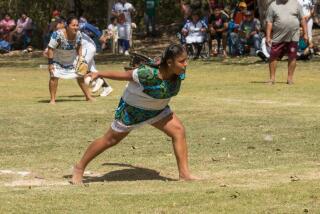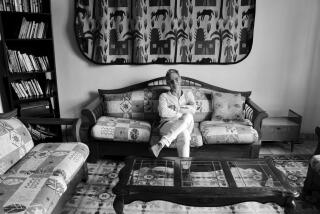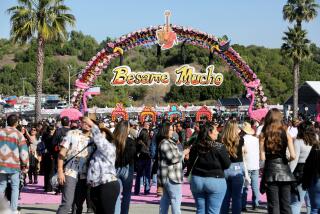100 facts for 100 years of Machu Picchu: Fact 50
- Share via
Friday marks the halfway point in our daily listing of facts marking 100 years since the rediscovery of Machu Picchu. Hiram Bingham III, a Yale professor, came upon the vine-covered ruins on July 24, 1911. Here, then, as we lead up to the century mark, are 100-plus facts about Machu Picchu, its country, its history and its players. We’ve been posting one each of the 100 days leading to the anniversary. Read from the bottom up.
50. Machu Picchu is hard to see from below. It is in a cloud forest (note to visitors: Mornings are often foggy) and has been overgrown.
49. If the Spaniards failed to find Machu Picchu, perhaps it’s because they were distracted by their desire for the spoils of war, which is partly what led to disagreements between Diego de Almargo and Francisco and Hernando Pizarro.
48. Francisco Pizarro was killed by the son and supporters of his partner, Diego de Almargo, who had been executed by Pizarro’s brother, Hernando.
47. Francisco Pizarro easily took over the city of Cuzco. Two years later, he founded Lima, where he died in 1541.
46. In 1533, Atahuallpa was executed, and explorer Francisco Pizarro began his march to Cuzco.
45.Amazingly, Francisco Pizarro’s men, who numbered less than 200, overcame 4,000 or so Incans and captured Atahuallpa, the Incan ruler.
44. In November 1530, Francisco Pizarro and Atahualpa, the Incan ruler, were to meet in Cajamarca, an Incan city in northern Peru. Pizarro told Atahualpa to give himself to Christ and the Spaniards, and when he refused, Pizarro decided to attack.
43. The governor of Panama thought the expeditions foolish, so Francisco Pizarro went to Spain to speak directly with the emperor, who said yes. Off Pizarro sailed.
42. Pizarro and his partner, Diego de Almargo, and a priest, Hernando de Luque, sailed down the west coast of South America twice.
41. Francisco Pizarro seems an unlikely player in that drama. He was a bit of a puzzle. Once, the explorer was marked as unambitious, but after a stint as mayor of a city named Panama (in, not surprisingly, Panama), he turned his attention to South America.
40. Where once there was an Incan empire, now there was a Spanish empire that endured for 300 years.
39. The conquistadors played a huge role in Peru, of course. Led by Francisco Pizarro, they claimed the land for Spain in the 1500s.
38. Did the Spaniards know of Machu Picchu? Hiram Bingham didn’t think so. “Yet so far as I have been able to discover, there is no reference in the Spanish chronicles to Machu Picchu. It is possible that not even the conquistadors ever saw this wonderful place.”
37. Hiram Bingham continued, “Surprise followed surprise until we came to the realization that we were in the midst of as wonderful ruins as any ever found in Peru.”
36. And what, really, could be? Here’s what Hiram Bingham wrote in Harper’s Monthly in 1913 about coming upon Machu Picchu. “... Suddenly we found ourselves in the midst of a jungle-covered maze of small and large walls, the ruins of buildings made of blocks of white granite, most carefully cut and beautifully fitted together without cement.”
35. Hiram Bingham found Vilcabamba, but he dismissed it because it wasn’t as grand as Machu Picchu.
34. Today, historians think the real Vilcabamba is close to Vitcos, an archaeological site, in the eastern Andes. Another swashbuckling explorer, Gene Savoy, came upon it in 1964 at a place called Espiritu Pampa.
33. Hiram Bingham thought he had found Vilcabamba, the true “Lost City of the Incas,” which was said to be where the Incas took refuge from the Spaniards.
32. Columbus, of course, thought he discovered Asia; Hiram Bingham thought he discovered the “Lost City of the Incas.” Both were wrong.
31. Here’s something Hiram Bingham and Christopher Columbus have in common: Both thought they had discovered some other place.
30. Like many explorers, Hiram Bingham didn’t know exactly what he found.
29. Hiram Bingham said in his Harper’s Monthly story, published in 1913, that a “local muleteer” may have been in Machu Picchu in 1902, based on scrawls he found on a wall. It seems clear that even if the Spanish didn’t know it existed, others certainly did.
28. Hiram Bingham may not have been the first European to find Machu Picchu. Some say it was a German named Augusto Berns who came upon it in 1867.
27. Hiram Bingham didn’t really discover Machu Picchu; the residents knew it was there, and a local Quechua-speaking guide, Melchor Arteaga, is said to have led him there.
26. Machu Picchu was, not surprisingly, declared a UNESCO World Heritage site in 1983.
25. When you enter Machu Picchu, you’ll see why it’s been designated one of the best-preserved pre-Columbian ruins in the world.
24. You can go to Machu Picchu and return to Cuzco in a day, but you’ll have more of it to yourself if you plan to stay a night or two. Day trippers usually leave by 2 p.m.
23. Aguas Calientes, which has grown haphazardly as tourist crowds have grown, offers accommodations, some basic and others more luxurious, and is the starting point for the ascent (by bus, if you wish) to the Incan citadel.
22. The train deposits you at Aguas Calientes, at the foot of Machu Picchu (which you’ll see spelled as Machupijchu).
21. In March and April, however, train travelers have been taking a bus from the Wanchaq Station in the Cuzco area, to Ollantaytambo and then taking the train to Aguas Calientes because of maintenance projects with the line.
20. Depending on the level of luxury you desire, your train trip to Machu Picchu could cost as little as $96 from Cuzco (for the Expedition train). It’s $142 for the VistaDome and $668 for the Hiram Bingham.
19. You have three choices of train travel to Machu Picchu: the Expedition, or backpacker train (basic), the VistaDome train (which has lots of windows, but if it’s warm outside, you may feel as though you are baking in a terrarium) and the Hiram Bingham, a luxury train operated by Orient Express.
18. Most visitors take the narrow-gauge train to Machu Picchu from the Cuzco area (usually departing from the Poroy station).
17. The five days’ journey from Cuzco refers to hiking to Machu Picchu, which you can still do today on the Incan Trail, a three- to six-day trip that requires good stamina.
16. Hiram Bingham wrote in Harper’s Monthly in 1913: “It seemed almost incredible that this city [Machu Picchu], only five days’ journey from Cuzco, should have remained so long undescribed and comparatively unknown.”
15.Cuzco, with a population of about 300,000, is the gateway to Machu Picchu, but don’t let the word “gateway” confuse you: Machu Picchu is 50 miles beyond Cuzco near the town of Aguas Calientes, far below the Incan ruins.
14. The symptoms of altitude sickness don’t generally occur until you’re at 8,000 feet. Depending on which yardstick you use, Machu Picchu may be less than that (or more). Some say it’s at 7,100 feet; others say 9,000. Bottom line: Cut yourself a little slack.
13. To help cope with the altitude, make sure you don’t get dehydrated and avoid drinking alcohol.
12. Some hotels provide oxygen for visitors; others offer coca tea, and it’s not unusual to find packets of coca leaves for sale. These can be chewed and are said to help relieve altitude issues. And yes, cocaine is produced from the leaves, but the amount of the alkaloid you’d ingest from the tea or chewing the leaves is small.
11. Among the problems AMS can cause (if you’re coming from sea-level California, be aware of this): headaches, shortness of breath, fatigue and/or nausea or vomiting. Consult a doctor before you go if you think you may have a problem. Symptoms usually disappear in four days, but in some cases, AMS may be fatal.
10. At 11,150 feet, Cuzco requires acclimation. Some people develop altitude sickness, also known as acute mountain sickness, or AMS.
9. Cuzco, sometimes spelled Cusco, means “navel” or “center” of the Earth. It certainly was the center of Inca civilization high in the Andes Mountains.
8. Legend has it that Manco Capac, the son of the sun god, and Mama Ocllo, daughter of the moon, established the seat of what would become an empire at Cuzco in the 11th or 12th century.
7. Much of what we know -- or think we know -- about the Inca society is hazy and often mixes fact with myth.
6. Because the Incas had no written language system (or one that we have yet figured out), the spellings of original words vary widely. Inca, for example, may be spelled Inka, Ygna or Inga.
5. The Incas, who created incredible architecture and political systems, had no known written system of language, although some scientists suggest khipu may also have served that function.
4. The Inca used khipu (spelled “quipu” in Spanish), a series of knots that functioned as a sort of counting system.
3. About half the population of Peru is Quechua, a South American Indian group. The group’s native tongue is also called Quechua. A dialect of that language was spoken by the Incas.
2. Peru shares borders with five countries: Ecuador, Brazil, Bolivia, Chile and Colombia.
1. At 496,218 square miles, Peru, in western South America, is about the size of three Californias. California, however, has about 8 million more residents than Peru.
More to Read
Sign up for The Wild
We’ll help you find the best places to hike, bike and run, as well as the perfect silent spots for meditation and yoga.
You may occasionally receive promotional content from the Los Angeles Times.







